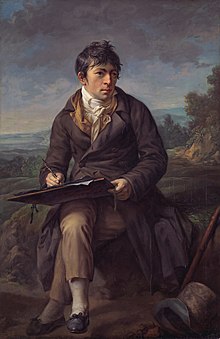Carl Anton Graff

Carl Anton Graff (born January 31, 1774 in Dresden ; † March 9, 1832 ibid) was a painter and draftsman who primarily devoted himself to landscape painting.
Life

Carl Anton Graff was the son of Anton Graff and his wife Elisabetha Sophie Augusta (1753–1812), b. Sulzer. His mother was the daughter of the theologian Johann Georg Sulzer . The godfather of Carl Anton Graff was Adrian Zingg , a friend and fellow painter of his father. Graff had four siblings, some of whom died shortly after birth. Together with his sister Caroline Susanne (born 1781), she married the painter Karl Ludwig Kaaz , a student of her father, he was the only descendant who survived his parents. When Anton Graff died in 1813, he left his two surviving children a fortune of 40,000 thalers.
Carl Anton Graff, who, like his father, did not devote himself to portrait art but to landscape painting, had learned the basic technical terms from his father. In Ludwig Richter’s opinion, however, no longer. Richter remarked sarcastically: “Now one of Dad's house friends was the landscape painter [Carl Anton] Graff, son of the famous portrait painter. He visited us almost every Sunday for an hour, where he and his father went back to their school days; (...) [Carl Anton] Graff, however, had not inherited any of his father's talent (...) His entire studio hung full of countless views of the Tetschen Castle , taken from all thirty-two sides of the compass rose; An eternally blue, possibly cloudless sky smiled over the long, smooth facade of the castle with its regular rows of windows. Since [Carl Anton] Graff could live on a small fortune, and was not married, but was always smoothly ironed, elegant Hagestolz , he only painted when boredom became too boring for him. In the summer he lived with Count Thun in Tetschen in pleasant sociable conditions and because of the art did not grow gray hair. "
Carl Anton Graff completed his further training mainly with his godfather Adrian Zingg .
From 1796 to 1798, the budding landscape painter and etcher Emanuel Steiner (1778–1831) , who came from Anton Graff's hometown Winterthur , was Anton Graff's pupil. Carl Anton Graff became friends with Emanuel Steiner. On June 27, 1801, the two went on a study trip together. This led them via Switzerland and Milan to Rome. Carl Anton Graff stayed in Rome until the end of 1807. His father regularly sent him letters to his correspondence address: al Signore Carlo Graff pittore al caffè greco Strada Condotti a Roma. The letter of July 13, 1804 also testifies to the lively correspondence between father and son. In it, Anton Graff comments on a picture sent to him by his son from Rome: “I liked your landscape that you sent me a lot , the main thing is good, but the color is too weak, it looks more like a drawing; I imagine the Italian regions to be very beautiful in color, but your work is still missing that. "
After the death of his brother-in-law Karl Ludwig Kaaz in 1810, he took on the two underage daughters of his sister Caroline Susanne in a fatherly manner. Carl Anton Graff was also considered an excellent violin player. Only a small part of his relatively few drawn and painted landscapes is known.
Carl Anton Graff's estate was auctioned off in Dresden in 1832. These included numerous works by his father.
Individual evidence
- ↑ Ekhart Berckenhagen: Anton Graff - life and work. Deutscher Verlag für Kunstwissenschaft, Berlin 1967, p. 168
- ↑ Ekhart Berckenhagen: Anton Graff - life and work. Deutscher Verlag für Kunstwissenschaft, Berlin 1967, p. 35
- ↑ Ekhart Berckenhagen: Anton Graff - life and work. Deutscher Verlag für Kunstwissenschaft, Berlin 1967, p. 38
- ↑ Ekhart Berckenhagen: Anton Graff - life and work. Deutscher Verlag für Kunstwissenschaft, Berlin 1967, p. 27
- ↑ a b Otto Waser: Anton Graff. Verlag von Huber & Co., Frauenfeld and Leipzig 1926, p. 57
- ↑ Ekhart Berckenhagen: Anton Graff - life and work. Deutscher Verlag für Kunstwissenschaft, Berlin 1967, p. 29
- ↑ Ekhart Berckenhagen: Anton Graff - life and work. Deutscher Verlag für Kunstwissenschaft, Berlin 1967, p. 42
- ↑ Ekhart Berckenhagen: Anton Graff - life and work. Deutscher Verlag für Kunstwissenschaft, Berlin 1967, p. 174
- ^ Richard Muther: Anton Graff - A contribution to the art history of the eighteenth century. Verlag EA Seemann, Leipzig 1881, p. 111
literature
- Ekhart Berckenhagen: Anton Graff - life and work. German publishing house for art history, Berlin 1967
Web links
| personal data | |
|---|---|
| SURNAME | Graff, Carl Anton |
| BRIEF DESCRIPTION | painter |
| DATE OF BIRTH | January 31, 1774 |
| PLACE OF BIRTH | Dresden |
| DATE OF DEATH | March 9, 1832 |
| Place of death | Dresden |